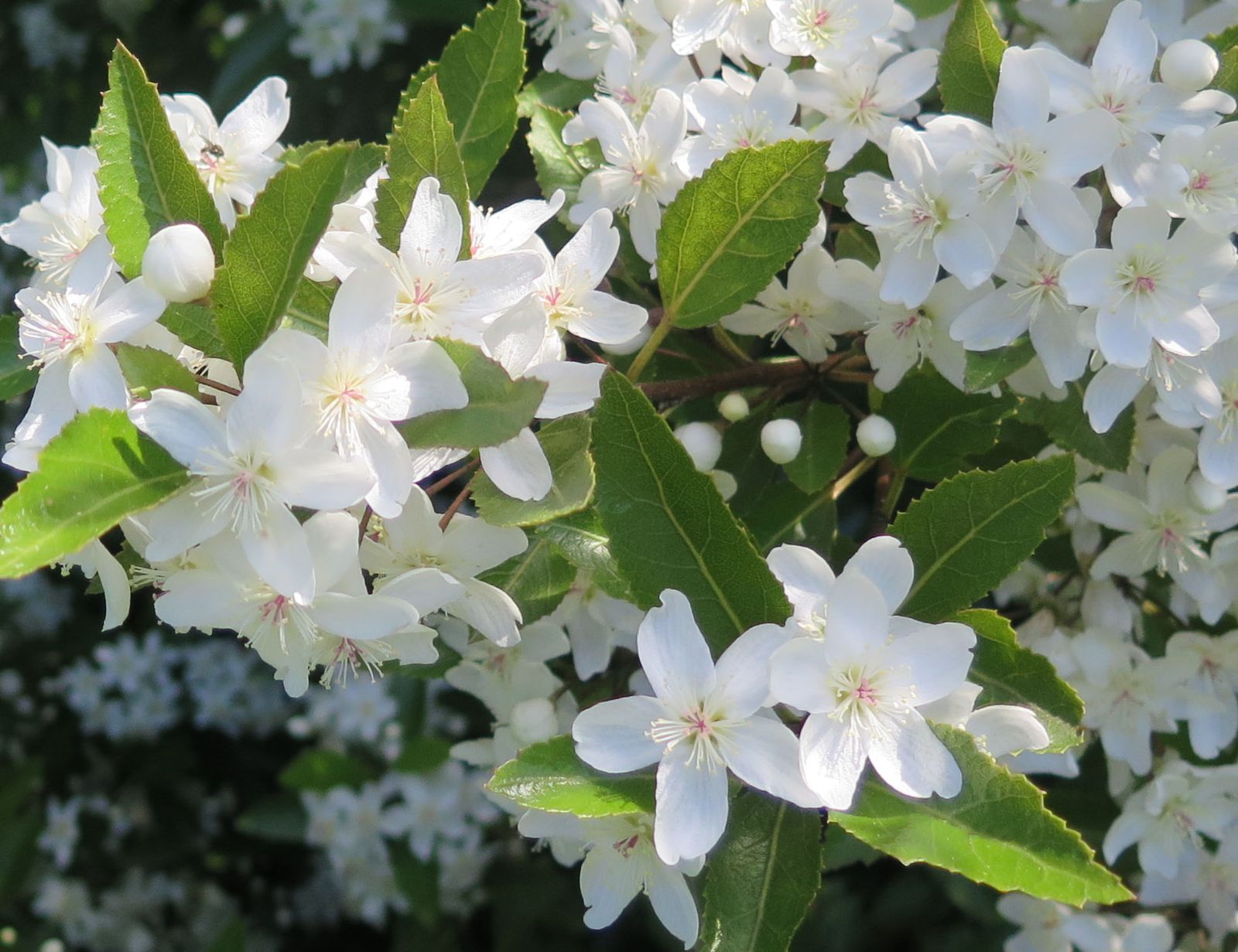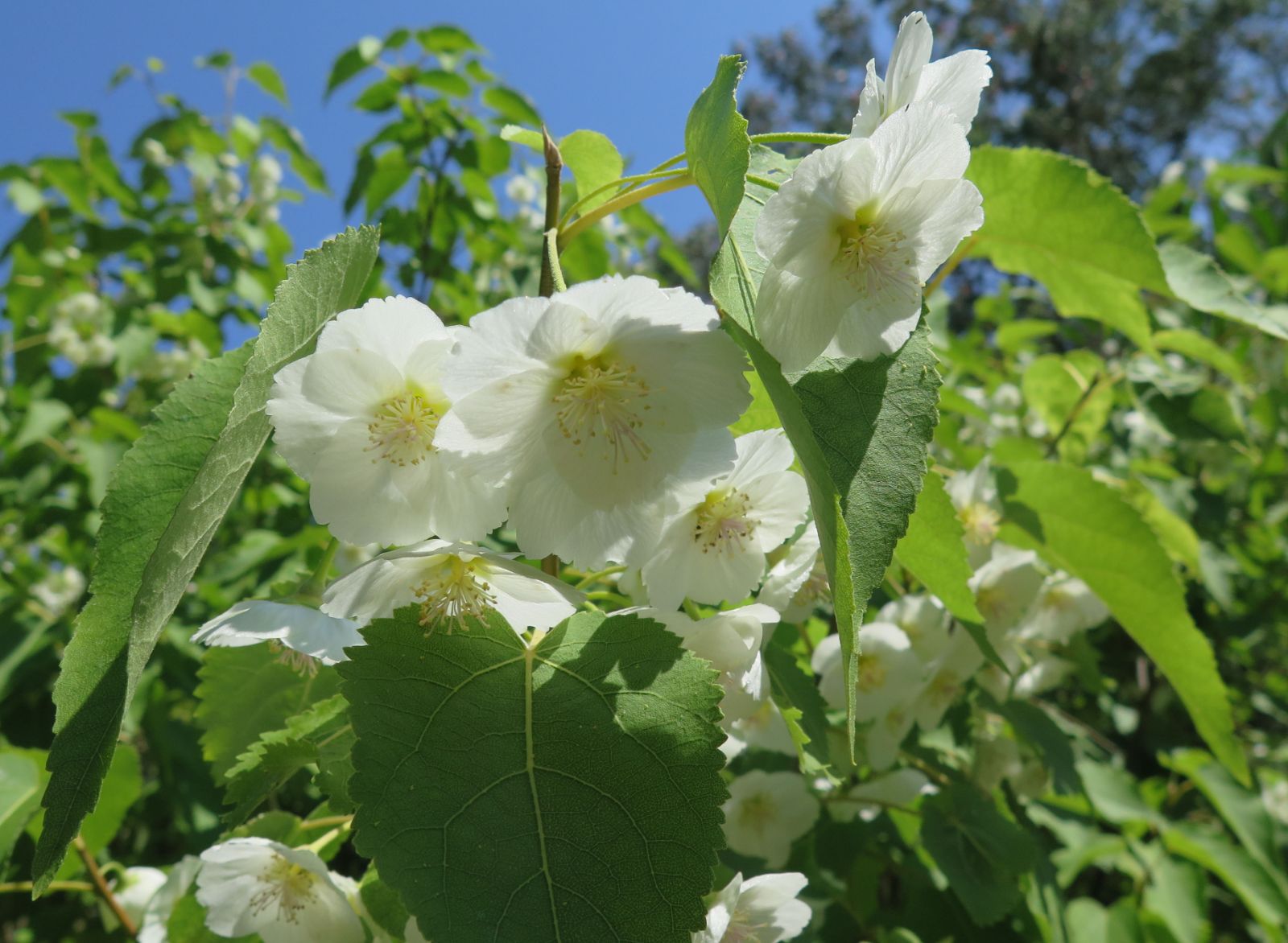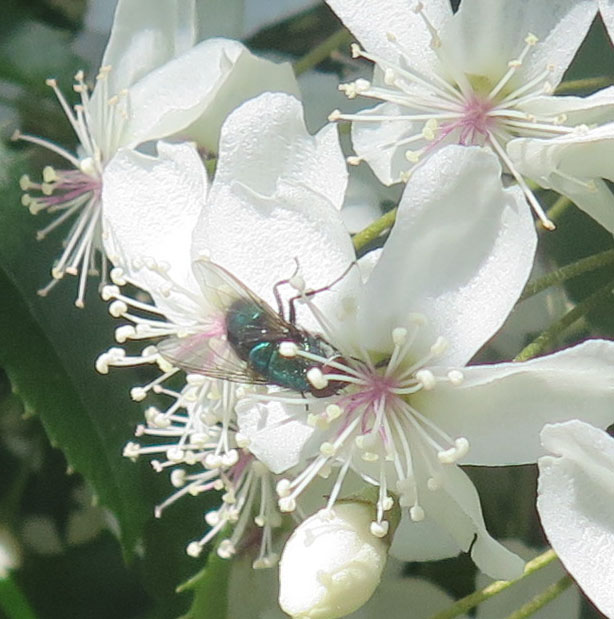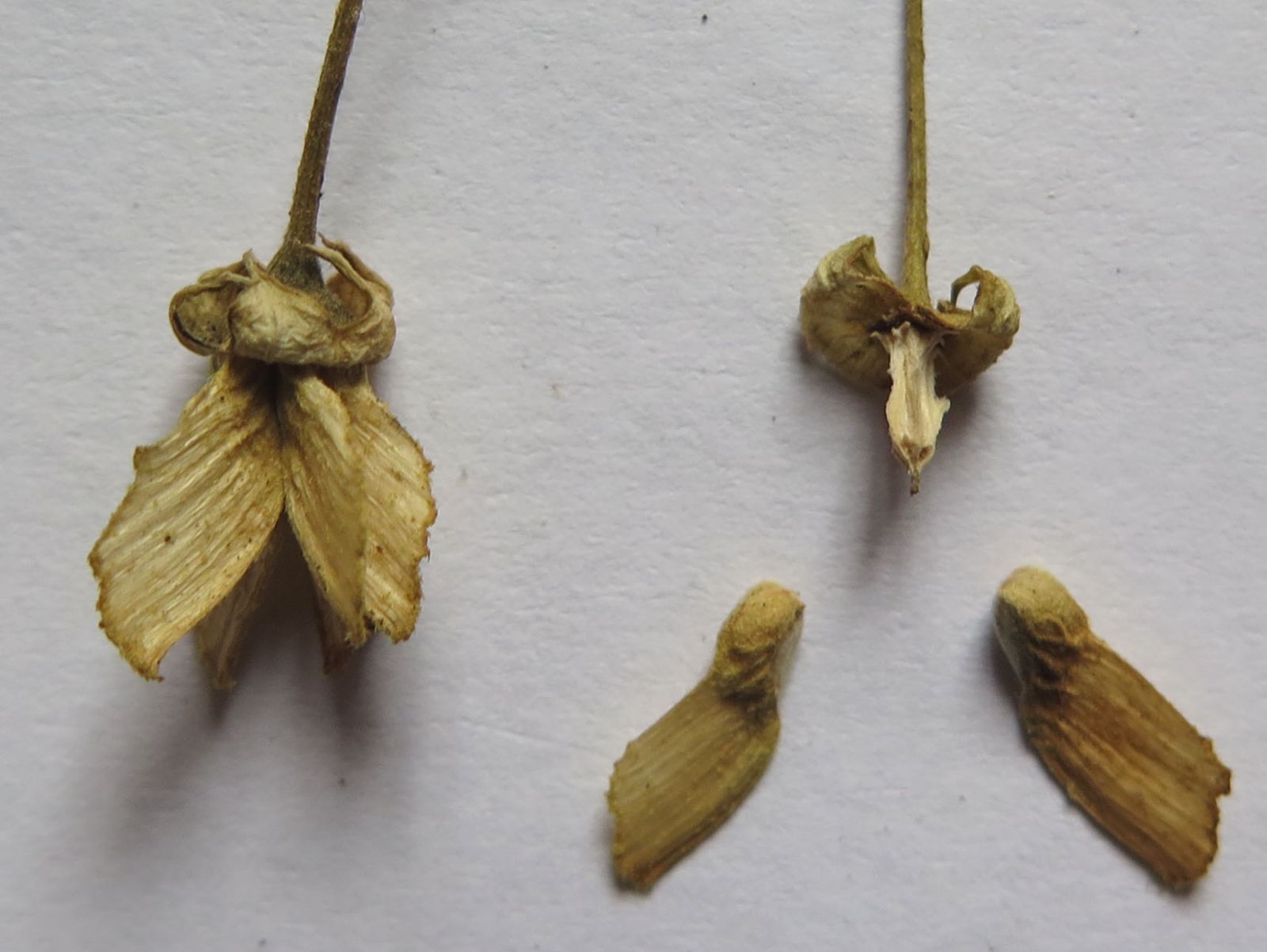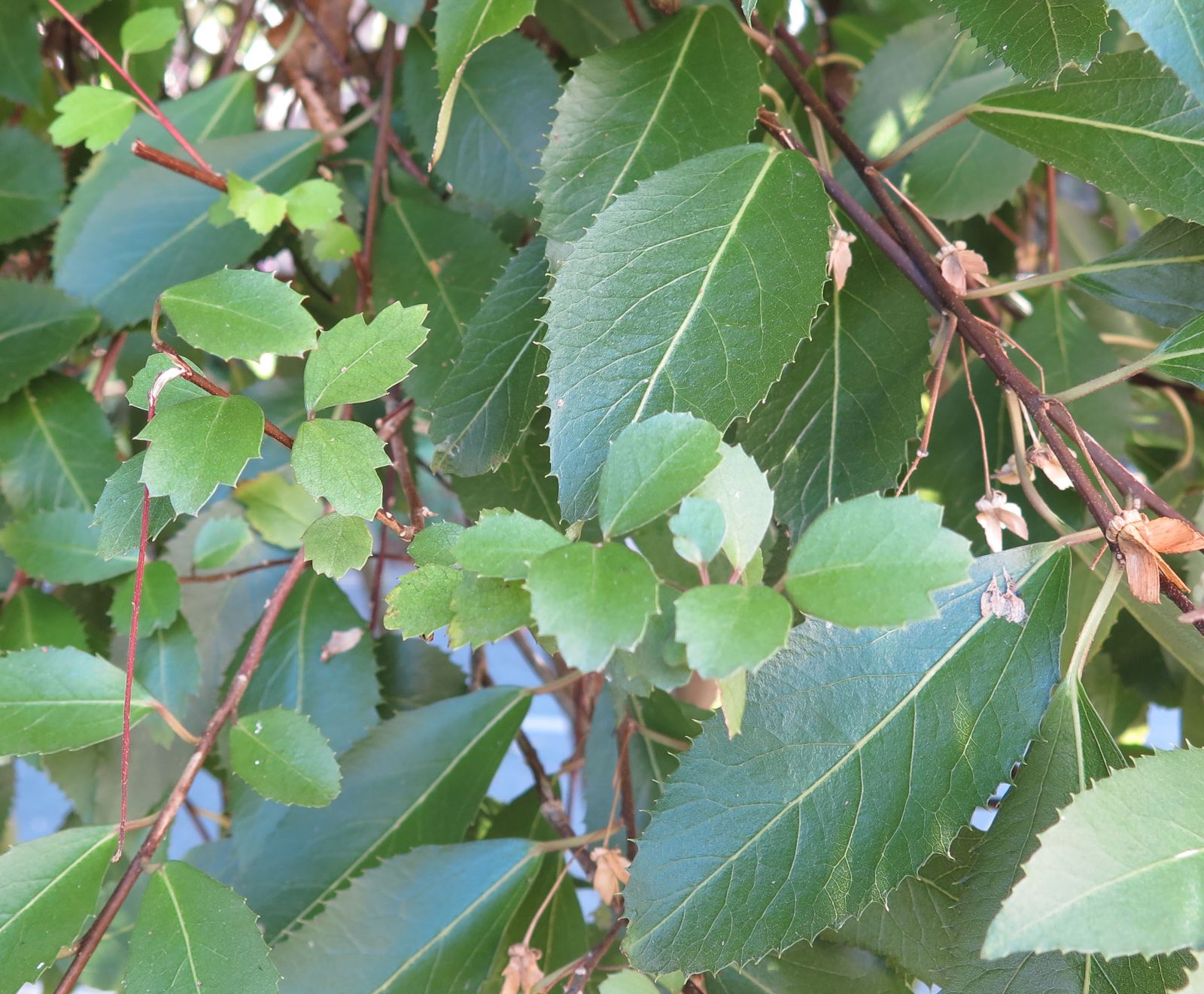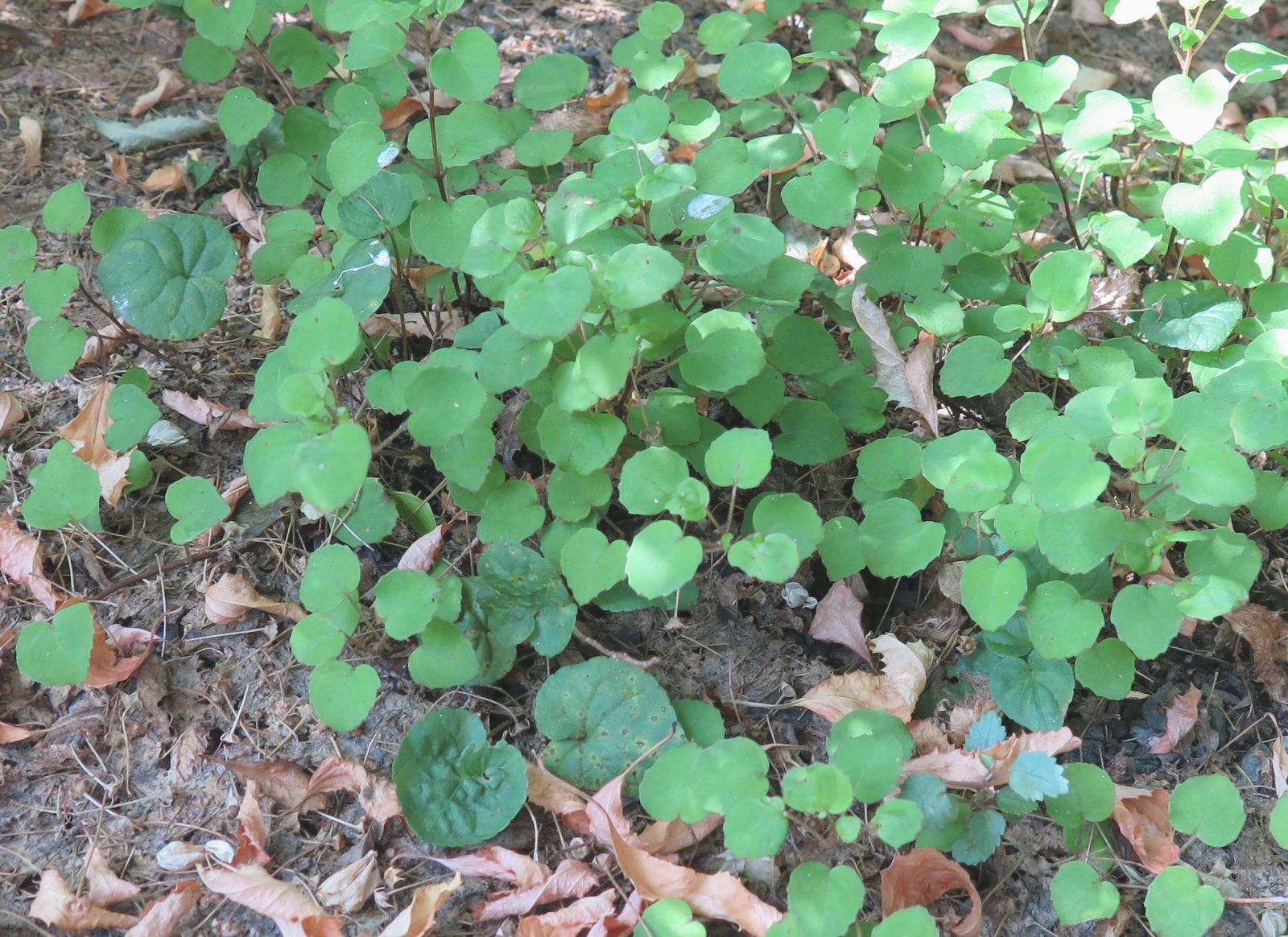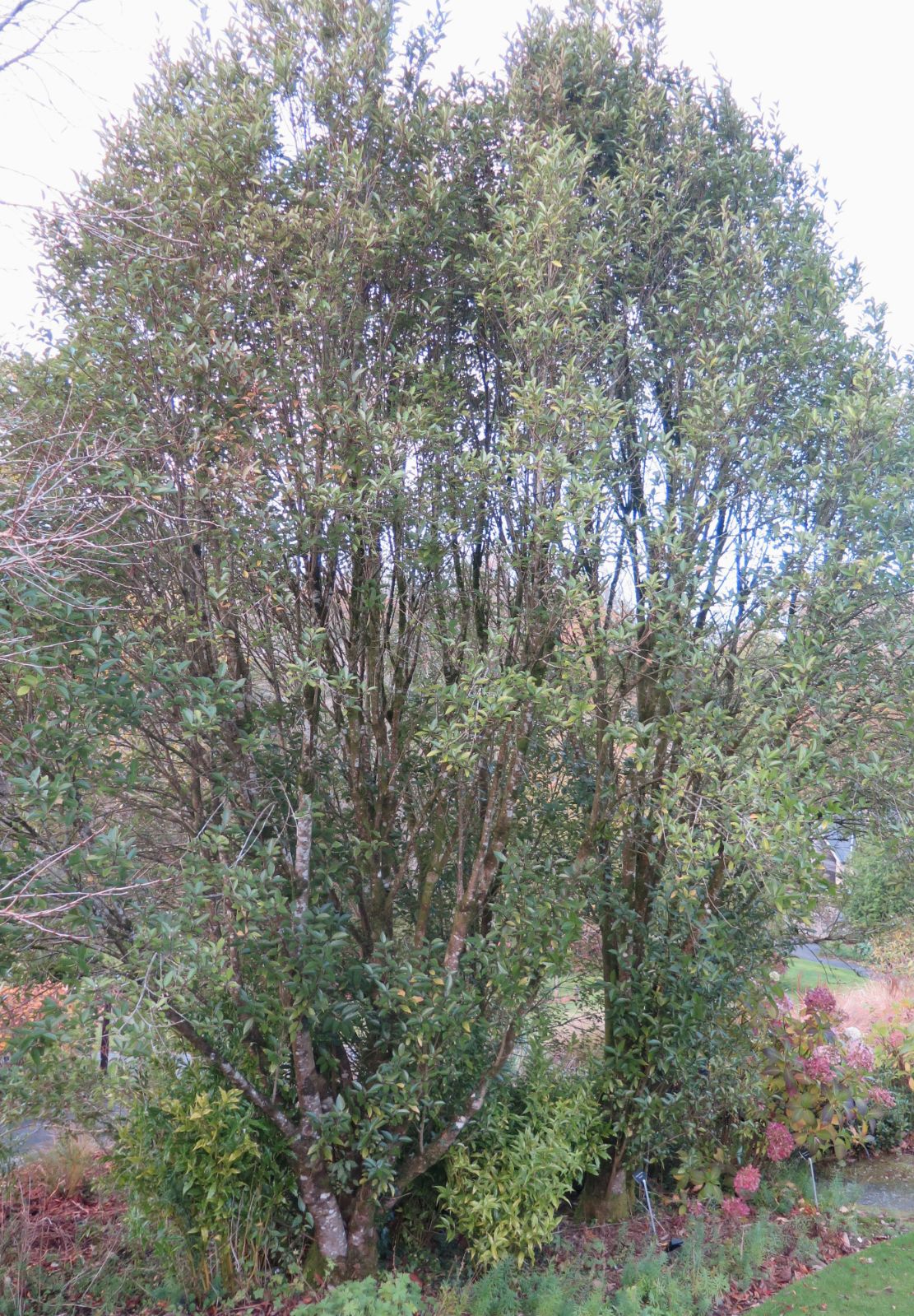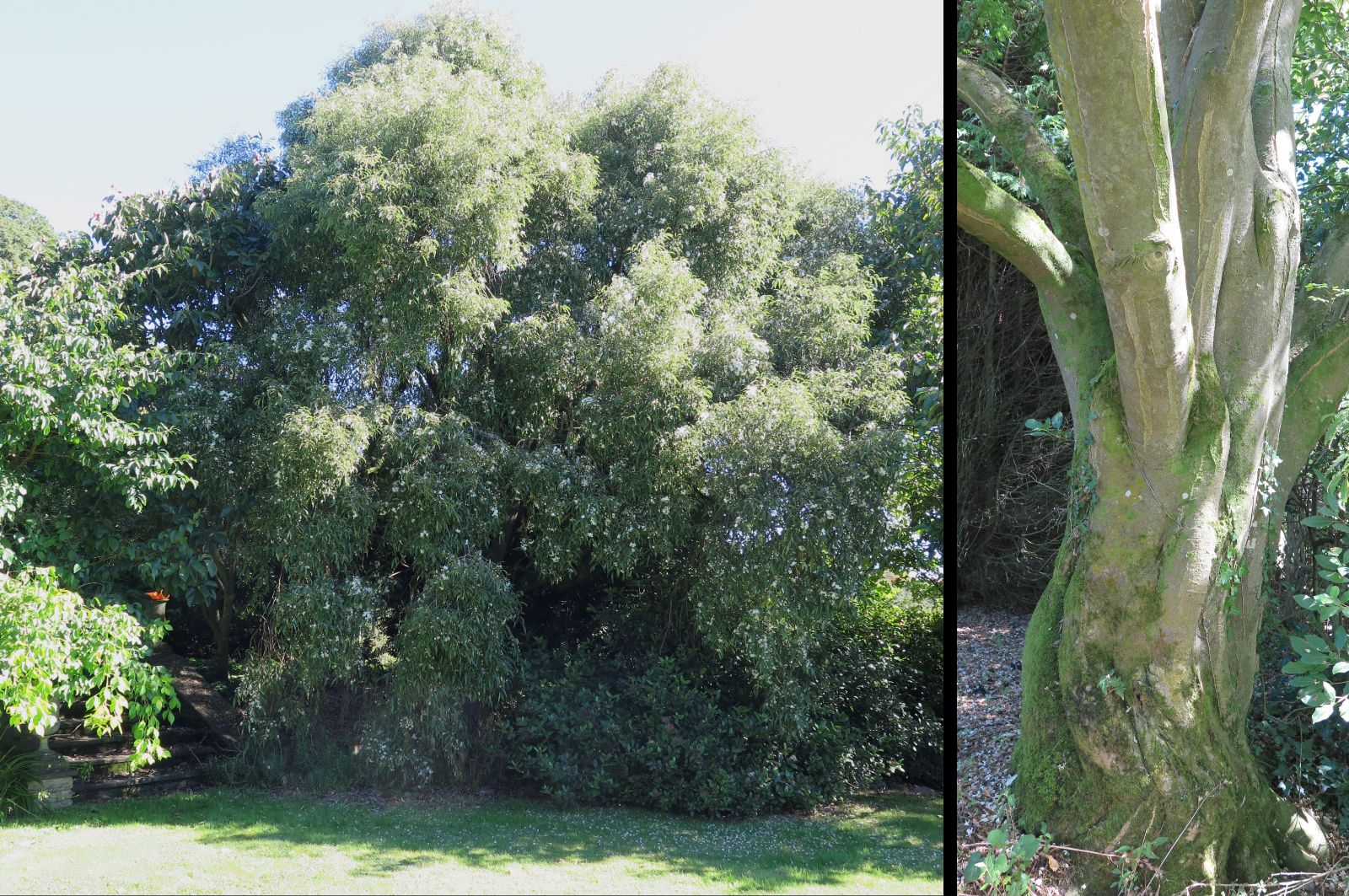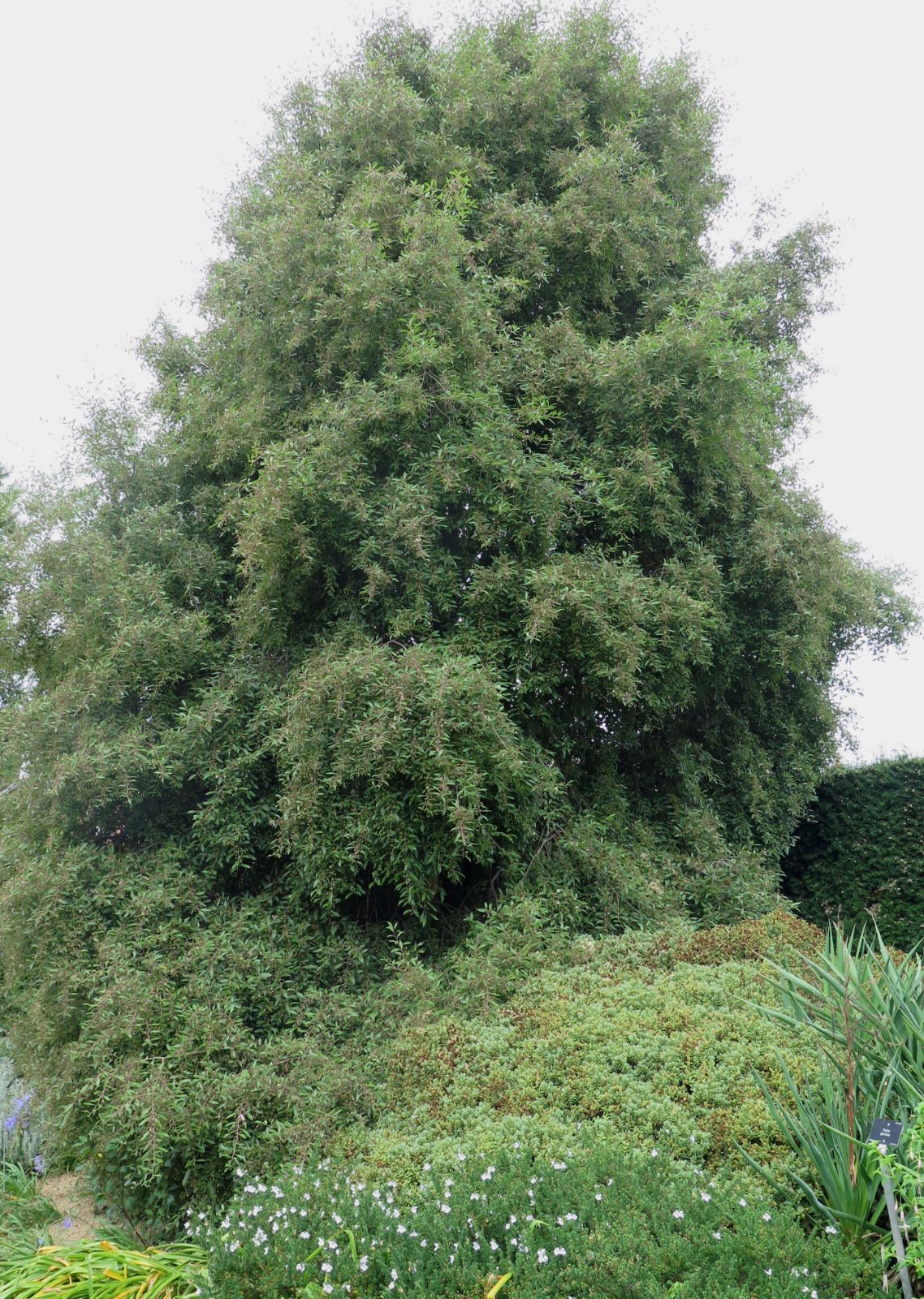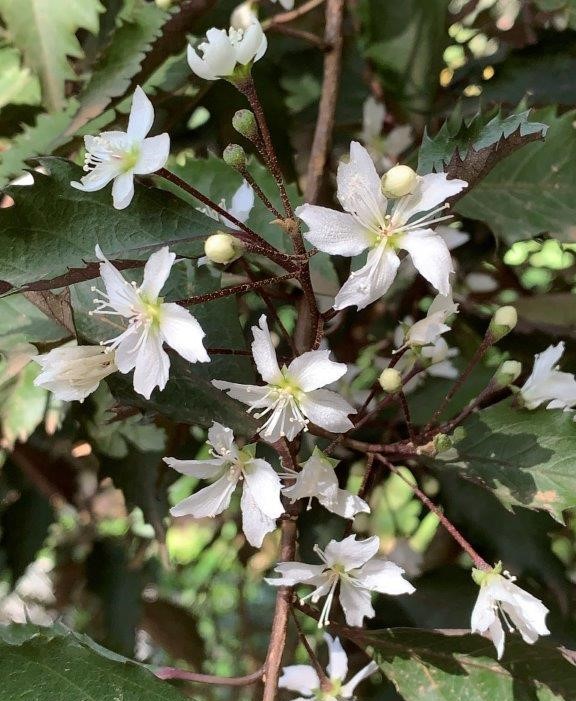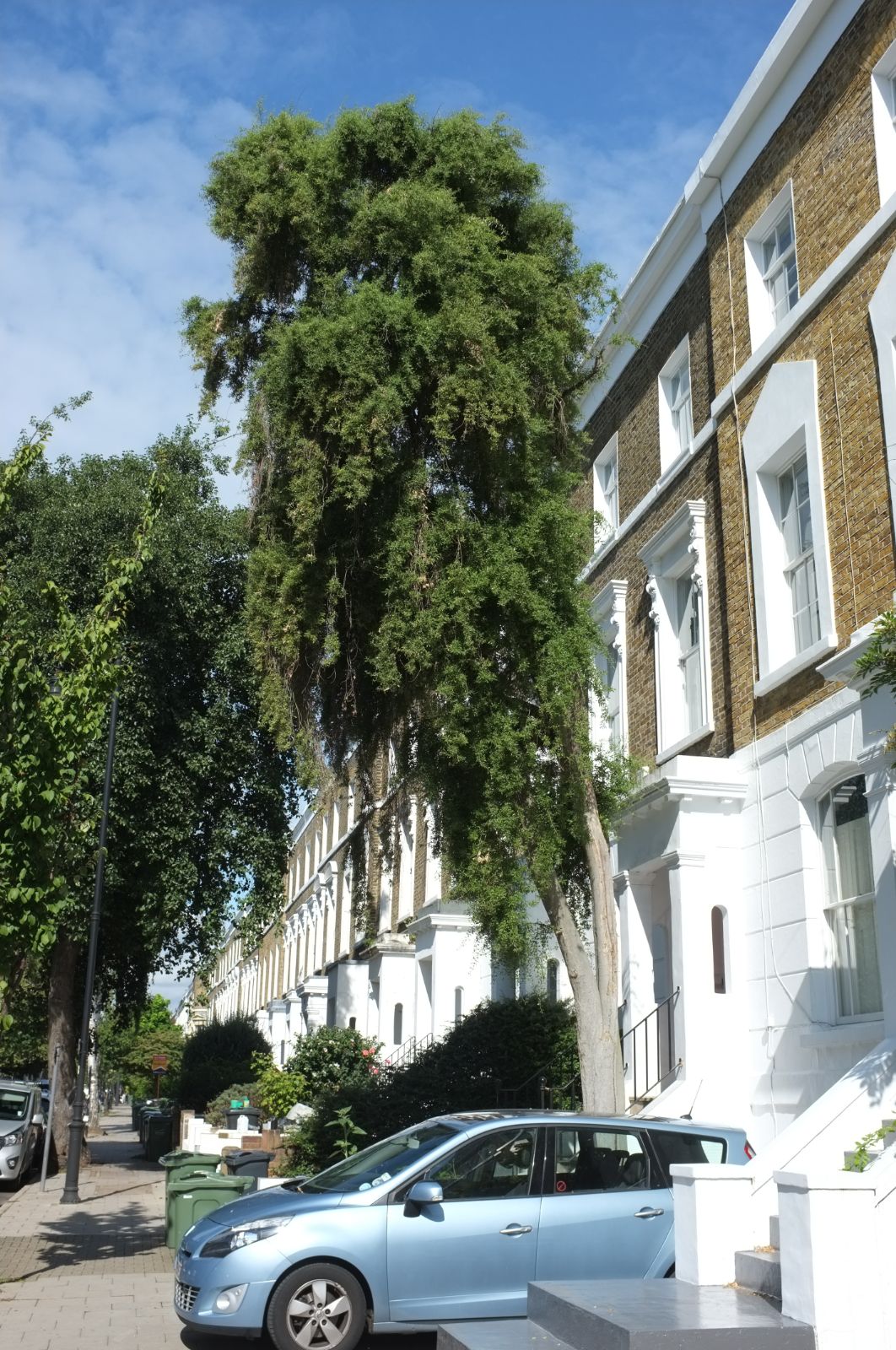Hoheria
Sponsor
Kindly sponsored by
a member of the International Dendrology Society
Credits
Julian Sutton (2021)
Recommended citation
Sutton, J. (2021), 'Hoheria' from the website Trees and Shrubs Online (treesandshrubsonline.
Family
- Malvaceae
Common Names
- Lacebark
- Ribbonwood
About 6 species of large shrubs and small to medium trees, endemic to New Zealand. Leaves simple, alternate, deciduous or evergreen, often with whitish stellate hairs. Most species are heteroblastic, the juvenile form having smaller, more deeply toothed or lobed leaves, and fine twiggy stems. Flowers bisexual, in the axils of the current year’s leaves, in small clusters or solitary. Sepals 5; epicalyx absent. Petals 5, white. Staminal column split above into 5 bundles of filaments. Styles equal in number to carpels, 5–15, stigmas capitate. Carpels winged or scarcely so, 1-seeded, separating from the central axis when ripe. (Allan 1961)
Hoherias are beautiful and quick-growing summer to early autumn flowering shrubs or small trees, for more or less sunny positions in the garden. They tolerate but do not require limey soils, and most are able to withstand a degree of summer drought. They are among that select group of white-flowered plants which reliably drop their ageing petals, so their garden impact is not lessened by old, brown flowers. Further, they routinely produce shapely specimens without the need for any formative pruning. They are underused in our area, especially in milder parts of North America, perhaps because the garden literature overemphasizes their tenderness under today’s conditions. Taxonomically difficult, they hybridize freely. This, along with short generation times and a history of seed-raising in cultivation, has led to great confusion in garden plants, where misnaming is almost routine: see below for further discussion on this critical point.
Hoheria belongs to Tribe Malveae of the Malvaceae. It is one of the few unambiguously woody genera in a group dominated by herbaceous (e.g. Malva) and subshrubby (e.g. Lavatera) plants (Stevens 2021). It is closely related to Plagianthus (q.v.), another woody New Zealand genus easily distinguished by its much smaller, inconspicuous flowers (5 mm or less across) which are sometimes unisexual. Hoheria appears to be sister to a group comprising Plagianthus plus the Australian Asterotrichion and Gynatrix. In turn, this group including Hoheria is sister to Lawrencia, also Australian shrubs and subshrubs (Wagstaff & Tate 2011). The implication is that either the ancestors of Hoheria and Plagianthus migrated separately from Australia to New Zealand, or their common ancestor migrated to New Zealand, followed by a reverse migration by the ancestor of Asterotrichion and Gynatrix. Although the divergence between Hoheria and Plagianthus etc. may be very ancient, molecular data suggest that the modern genus diversified during the late Tertiary, probably coinciding with the rapid uplift of the Southern Alps over the last 5 million years (Wagstaff, Molloy & Tate 2010).
‘Hoheria is a genus in need of a modern systematic revision’ (New Zealand Plant Conservation Network 2021). The species are poorly distinguished, variable, interfertile, hybridizing where they meet naturally or through human activity, and of uncertain number. We follow Royal Botanic Gardens, Kew (2021) in accepting six species, with no great confidence. The Mountain Ribbonwoods (H. lyallii and H. glabrata) form a fairly distinct group to either side of the Southern Alps, set apart by their fully deciduous leaves, generally larger flowers, and more numerous (8–15) carpels; they are distinguished from one another by distribution, ecology and hairiness. There are three evergreen species on the two main islands, not always easy to distinguish in some forms. H. populnea is the most northerly, most tender and usually last to flower. H. angustifolia has smaller, narrower leaves than the others, with long, acuminate teeth; its juvenile form is a divaricating shrub. H. sexstylosa is intermediate between these two in leaf shape, and often has more (6–7) carpels. H. equitum is restricted to two small, northerly island groups; it differs from H. populnea in its leathery leaves with entire, recurved margins; probably very tender, it is not grown in our area, and we do not discuss it further. One more controversial species, H. ovata, might be encountered in recent literature. Discussed here under H. sexstylosa var. ovata, it may be a stable hybrid; the name (and perhaps the plant itself) seem not be in known in cultivation.
We are a long way from understanding the relationships between these species. The clearest conclusion to be drawn from the most thorough molecular study to date (Wagstaff, Molloy & Tate 2010) is that following long-distance dispersal to New Zealand, hybridization (presumably alongside adaptive radiation) has been an important factor in Hoheria evolution. This is in line with many studies of island endemic plant groups, in Hawaii and Macaronesia. There seem to be no strong genetic barriers to breeding, and the lesson of cultivation is that these are self-fertile trees. All share the same chromosome number (2n = 42). The open, bowl- or saucer-shaped flowers with a central mass of stamens are visited by diverse flies, bees, butterflies, moths and even birds, collecting nectar and/or pollen (Newstrom & Robertson 2005). This generalist strategy again works against genetic isolation of the species.
While firmly attached to one another in flower, the single-seeded carpels separate from one another and from the central axis when ripe. Each develops a wing after flowering (rudimentary or absent in the Mountain Ribbonwoods), allowing seeds to be dispersed individually by the wind.
Hoherias are all heteroblastic to some degree, with a different leaf form and often growth habit in the juvenile phase. Mature plants often show juvenile features on shoots regrowing after damage or pruning. In general, juvenile leaves are smaller and more deeply toothed, or even lobed; their stems are often thin and wiry. At one extreme, H. populnea only rarely exhibits juvenile foliage. At the other, H. angustifolia has a truly divaricate juvenile form. Divaricate shrubs make a dense tangle of widely branching, fine stems. Some, such as the familiar Corokia cotoneaster remain this way throughout life; others such as H. angustifolia go on to produce an adult tree form growing up from within the mass. Around 10% of the New Zealand woody flora is divaricate at least for part of the life cycle (Greenwood & Atkinson 1977). Two types of explanation have been advanced. One suggests that this habit is an adaptation to avoid browsing by moas (Greenwood & Atkinson 1977), a group of large, flightless birds which became extinct in the 15th century, within about 100 years of humans colonizing New Zealand (Worthy & Holdaway 2002). Others invoke climatic adaptations, either as a protection from frost, wind or dry air (McGlone & Webb 1981) or providing self-shading to protect against cold-induced photoinhibition (Howell, Kelly & Turnbull 2002). Uncertainty and disagreement remain.
While their wood has sometimes been used in furniture making, hoherias are not significant timber trees. Most traditional uses centre on the bark, both the strips of outer bark which peel off larger trunks, and the mesh of fine bast fibres beneath: various uses in ropes and fixings are recorded (Landcare Research 2021). In New Zealand, Hoheria and Plagianthus bast have been major raw materials for tapa, a felted cloth made wherever Polynesian cultures established; elsewhere in the Pacific members of the Moraceae such as Broussonetia papyrifera were used instead (Smith et al. 2020). Various preparations of bark or other plant parts have been used medicinally by the Māori, especially for relieving soreness and inflammation (Landcare Research 2021). Hoheria species are valued by New Zealand beekeepers for their supply of nectar and pollen later in the season (Newstrom-Lloyd & McPherson 2017). The generic name is derived from the Maori houhere, used for all species (Landcare Research 2021).
Outside New Zealand, hoherias have been grown as ornamentals mainly in the British Isles. This is probably due to the close cultural ties between Britain and New Zealand, as well as their suitability for mild oceanic climates. H. glabrata and probably H. lyallii (all labelled lyallii since H. glabrata was not published as a distinct species until the 1920s) were in Britain by the later 19th century, and all the species we describe here were apparently in cultivation by the 1930s (Arnold-Forster 1948). They should be tried more in coastal areas of western and northern France, and the Low Countries. In North America, where hoherias are virtually unknown as garden plants, they should be tested far more in more temperate parts of the Pacific Northwest: plantings in Seattle’s Washington Park are leading the way in this (University of Washington Botanic Gardens 2021) .
The garden literature has tended to emphasize their tenderness as a group, encouraging their use only in mild, coastal gardens in southern and western Britain and Ireland. However, some are hardier than others (H. glabrata is generally the hardiest, H. populnea the least so, but stocks vary). With the current trend towards less severe winters, many hoherias are worth trying in lowland gardens almost anywhere in Britain: they are sufficiently fast growing that even if damaged by the hardest winters, a good show will probably be possible before this happens. Full sun is ideal; even though some grow in woodlands in the wild, they are not plants of dense understory, and anyway the New Zealand sun is considerably higher in the sky. With the possible exception of H. glabrata, hoherias are tolerant of summer drought, and well drained soil is ideal; winter drought should be avoided. Soil pH seems not to be an issue in gardens, although in the wild H. lyallii is a calcicole (Hutchins 2006). These are excellent plants for exposed coastal gardens, and are sometimes recommended for windbreaks or even informal hedges (Arnold-Forster 1948). Pruning requirements are minimal. After severe winters it may be necessary to cut damaged branches back to live wood. Most hoherias sprout readily from the base to make multistemmed specimens, so occasional clearing may be needed if clear trunks with planting space beneath are desired.
Fresh seed germinates readily, with no need for special measures. Given bottom heat, they can be ready to prick out by late autumn, and may be planted even before the parent tree next flowers. Carpets of self-sown seedlings are often seen under established trees. Steve Griffith observes that in the National Collection at Abbotsbury Subtropical Gardens, Dorset, they are ‘the worst weed’ (pers. comm. 2021). Gardeners and (too often) nurseries have cheerfully distributed seedlings which are frequently hybrids (see below). With cultivars, and with all species if any other Hoheria is grown, vegetative propagation is essential. Cuttings taken in autumn or spring give ‘reasonable’ results (Hutchins 2006), but some are trickier than others. Roderick White reports complete failure in rooting two cultivars of H. lyallii, ‘Chalk Hills’ and ‘Swale Stream’ (pers. comm. to J. Grimshaw 2021). As potted nursery subjects they are fast-growing, quickly rooting through. On a commercial nursery which bought in rooted cuttings in 9 cm pots annually from a wholesaler, Ben Probert found that by potting some directly into 12 litre pots, while the bulk went into 2 or 3 litres, with careful attention a profitable range of sales plants could be achieved in only a few weeks (pers. comm. 2021). Keeping them in peak condition for a long period is challenging, and a nursery might aim to have a steady supply of rooted cuttings through the season.
Several factors conspire to make misnaming and unrecognized hybridization very serious issues with Hoheria in gardens. These are: the similarities between species; variability within species; probably relatively few introductions of wild material to Europe; interfertility; the ease of seed raising; abundant self-seeding; fast seedling growth; flowering from a young age; and finally the fact that few people are really familiar with a wide range of hoherias. Seldom was the cliché ‘perfect storm’ more apt. In researching for this article it has become clear that even some widely grown cultivars (e.g. ‘Glory of Amlwch’) are often replaced by impostors. Scepticism, caution and careful observation are needed when identifying garden plants. Labels should not be trusted too much, even in well-curated collections. Repeating a dubious identification as fact serves no one.
Descriptions of species are based on the literature of wild plants in New Zealand, rather than on plants grown under the name in Britain. As far as possible, detailed cultivar descriptions are based on direct observation of specimens with good provenance, hence some are more thorough than others. More detail will be added to the remainder once trustworthy specimens are found. Unlike most garden literature, we have not tried to attribute garden-origin cultivars to species where there is any doubt. The key (to species only) is modified from Allan (1961). Garden plants which do not unambiguously key out are probably hybrids; those which do might still be hybrids!
Identification key | ||
| 1a | Evergreen, carpels (and styles) 5–8, carpels with pronounced wing in fruit | 2 |
| 1b | Deciduous, leaves not tapered at the base, carpels (and styles) 8–15, wing obscure or absent | 4 |
| 2a | Leaves clustered towards branchlet tips, narrowly oblong, obtuse or acute, rarely more than 3×1 cm, teeth with long spinulose tips | Hoheria angustifolia |
| 2b | Leaves ovate, acute or acuminate, mostly at least 5×2 cm, teeth not spinulose | 3 |
| 3a | Flowers usually in clusters of 5–10, flowers 25 mm or more across, carpels 5(–6) | Hoheria populnea |
| 3b | Flowers mostly in clusters of 2–5, flowers not usually more than 20 mm across, carpels (5–)6–7(–8) | Hoheria sexstylosa |
| 4a | Stellate hairs on leaves usually copious; stigmatic surface decurrent | Hoheria lyallii |
| 4b | Stellate hairs on leaves sparse to moderate; stigmatic surface not decurrent | Hoheria glabrata |

